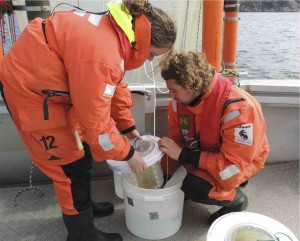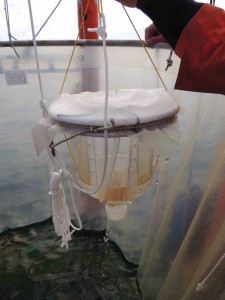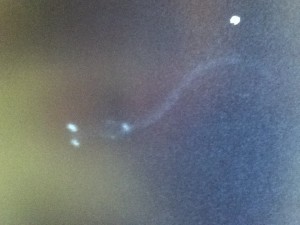After we had placed the herring eggs into the mesocosms enclosed in their incubators about two weeks earlier, we calculated that they should have been hatching around the 11th May, spread over two to three days. Around that time Micha has been checking on them daily to see whether the first ones have hatched. The idea was to introduce about 500 to 1000 Larvae into each mesocosms as soon as peak hatch was over and most larvae had hatched. A couple of days ago we got very nervous, when all we saw in the incubator were a couple of dead larvae and not a lot of unhatched eggs on the plates. More than slightly anxiously we got all the incubators out of the mesocosms and let the water drain in buckets onboard of WASSERMANN…
…and found no alive larvae. A closer look at the plates, however, showed that there were also no eggs left which were about to hatch. But there were very little dead larvae in the incubators either. The only explanations were that basically none of the eggs developed properly and no larvae ever hatched or that they must have escaped from the incubators, which we first thought impossible… well – luckily – it turns out that we were probably very wrong.
The incubators were designed to float at the surface with the styrofoam above the water. We had, however, decided to sink them to several meter depths using diving lead, since this offered more stable conditions for the herring eggs. The gauze on top probably lifted a little when the incubators were moved downwards and this opened a tiny ‘escape route’ between the Styrofoam and the bottle.
Luckily we had taken pictures of the eggs on the plates before bringing them into the mesocosms and so we could compare them to the number of eggs on the plates now. To convince even the pessimistic parts of the group, the difference in egg numbers showed that several hundred eggs hatched on the plates. It very much looked like the herring larvae were eager to join the party in the KOSMOS and were not prepared to wait until we had decided that they were ready. Like all children they just knew best when it was time to conquer ‘the real world’ and obviously didn’t feel like an emotional good-bye from their “parents”.
However, to really let us sleep peacefully again, we wanted to make extra sure that there were indeed herring larvae in the mesocosms: yes” camera was lowered into some of them and luckily, there they were:
Not finding any larvae wouldn’t have proven anything since we calculated that possibly 1,000 larvae might have escaped. This amount in 55,000 L of water would result in one – teeny-weeny (less than a cm), completely transparent, but reasonably fast swimming – larvae in 55 L of water. The odds of finding them are therefore quite small and seeing a few is an extremely good sign. A couple of larvae were seen on camera and quite a few were also found today in the sediment samples. So it looks like the herring larvae had decided that it was time for fish larvae in the KOSMOS and had made it happened on their own. We will count all the eggs on the plates now and will then be able to calculate how many alive larvae should have made it into each of the mesocosms.
So keep your fingers crossed for our brave, impatient and very eager little larvae, so that they will make it on their own and find some food and stay tuned to hear about them again after our first proper sampling.